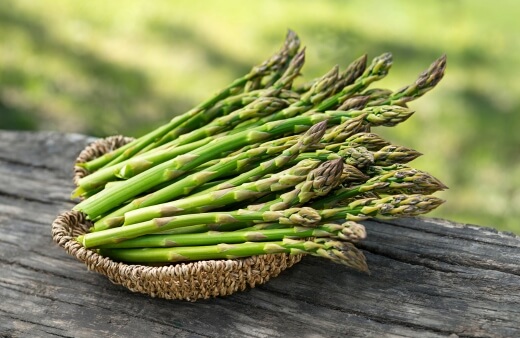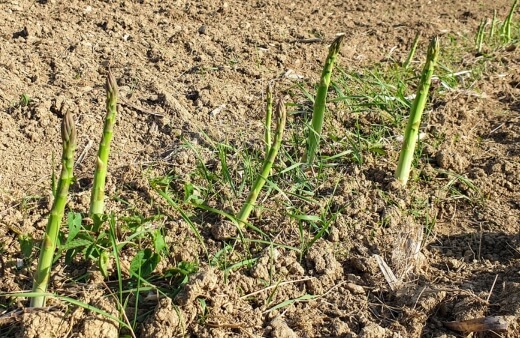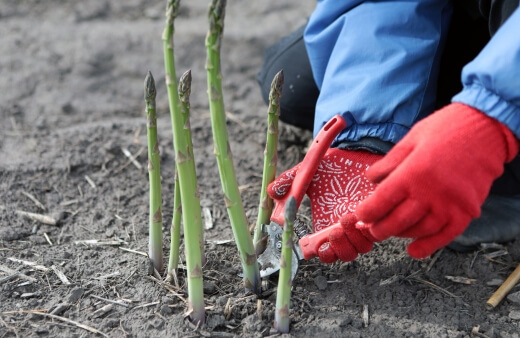Asparagus is a great spring vegetable that’s easy to grow in your home vegetable garden and is the perfect addition for BBQ sides, salads, starters and getting your daily greens! Here are some tips on how to grow asparagus and care for these plants in order to get a healthy, tasty crop every time.
More...

What is Asparagus?
Asparagus officinalis, commonly known as Asparagus, is one of the few perennial vegetables you can grow at home. Because it is happiest being kept in the same spot for years on end, it’s important to choose a spot that offers a lifetime of perfect conditions.
It’s a very distant relative to the onion and a member of the Liliaceae family, the same family that includes beautiful flowering lilies. It originates from the eastern Mediterranean, and is incredibly adaptable, so it’s commonly found through Egypt, Greece and even China.
The spears, which are the part you eat, are the young shoots of the plant, but the fern-like foliage is very pretty too, turning from a soft green to golden in the fall and making this vegetable a great ornamental plant.

Types of Asparagus
There are two main varieties – the green asparagus, which is mainly cultivated in North and South America and China, and the white variety, which is mainly cultivated in Europe.
Common varieties of green asparagus:
- Princeville Asparagus – Ideal for warmer climates
- Jersey Giant Asparagus – An early yielding variety with good resistance to rust and fusarium wilt
- Apollo Asparagus – A good variety for both warm and chilly climates that is very disease-resistant
- Purple Passion Asparagus – An unusual and pretty purple variety
- Mary Washington Asparagus – The most common variety, with good rust resistance
- Brock Imperial Asparagus– A very high-yielding variety
- Precoce DÁrgenteuil Asparagus – A rare Italian variety with thin stalks and rose-coloured buds
- Atlas Asparagus – A great variety for hotter climates
How to Grow Asparagus in Australia
Best Conditions to Planting Asparagus
Like other vegetable plants, asparagus need the right conditions in order to thrive.
Light and Temperature
These plants love full sunshine! Too little sunshine can produce stunted plants and thin spears. It grows well in almost any climate, but does especially well in cooler climates and places with longer winters.
Your plants will start shooting in early spring as the temperature reaches 10°C, and will start growing vigorously when daytime temperatures reach 21-29 and night-time temperatures are 15-21°C.
Any frost will discolour those first tender shoots, so it’s advisable to cover or protect the plant if it’s still icy out.
Soil
Because this is a long-term plant, start by removing stones and weeds, and creating rich, well-draining soil in the bed. Add lots of compost and organic matter as well as rock phosphate/bone meal for healthy root growth, and aim for a neutral soil pH of 6.5-7.
Watering Asparagus
Asparagus love regular, deep watering, especially when the plants are young. They do very well with drip irrigation, but watering asparagus gently each day or as the soil gets dry with a hose is just fine. Aim to wet the base of the plant only, supplying 5 cm of water a week.
Fertiliser
If your soil is well-prepared, it will feed your asparagus well over the growing season. It’s a heavy feeder, so it’s recommended to also apply a top dressing each new season to re-infuse the soil. Give it a full dose of .5-.7 kg of 10-10-10 fertiliser in mid-spring and after the last harvest.
Pruning
After the foliage has turned brown, cut the plant back to the soil surface and apply a good layer of mulch and compost. This will help protect the plant from the cold. Check out our list of the best pruning shears on the market.


Get Your Free Guide:
Master Growing Australian Natives eBook
A Must Have Complete Guide for Every Australian Garden
Get Your Free Guide:
Master Growing Australian Natives eBook
A Must Have Complete Guide for Every Australian Garden
How to Propagate Asparagus – Seed or Crown?

There are two ways of propagating asparagus, and both work very well and are easy to do. For a family of four asparagus lovers, 25 plants are plenty. The first thing you need to know about growing asparagus is that you’re in this for the long haul.
Unlike other vegetables that you can plant in spring and harvest in summer or fall, asparagus takes 2-3 years before harvesting. Don’t worry, however, once it gets settled in you will have more asparagus than you’ll know what to do with!
Propagating Asparagus from Seeds
- Pick up some seeds from your local garden centre.
- In northern climates, start growing your seedlings indoors about 4 weeks before the last expected frost in newspaper pots along a sunny window, keeping the soil moist.
- When the seeds have sprouted and the last frost has passed, plant them 5-7.6cm deep in a prepared bed.
- Watch for tiny flowers to appear. The female flowers have well-developed, three-lobed pistils while the males have larger, longer flowers.All the female plants should be removed.
Asparagus Propagation from the Crown
- Buy a crown from your local garden centre. Don’t be put off by how it looks! It might look like a dead, stringy mop right now, but it will flourish when planted.
- A good crown is firm and fresh. Avoid any that look withered or have soft spots.
- You can keep the crown exposed to the air for a while, just keep it in a dry, cool spot.
- In the spring, make a trench about 30 cm deep and 30 cm wide in well-prepared soil, with mounds about 45 cm apart.
- Place the crown on the mound, spreading the roots down the sides of the mound, with the top of the crown 15 cm below the soil line.
- Cover the crown and water regularly.
Harvesting Asparagus
Only harvest asparagus 2-3 years after it has been planted. This will give the plant the time it needs to become strong and healthy, so stay patient! When harvesting, snap off the spears or use a clean, sharp knife and cut the spear off just above the soil line.

Be careful of the small spears below the soil line that has not emerged yet.
- 3rd year of growth – Only harvest every 2 weeks until summer arrives, especially if you notice the spears are quite small, letting the foliage develop fully.
- 4th year of growth – Harvest spears when they reach 12-17 cm long and before the tip becomes loose. You can harvest every 4-6 weeks.
- After the 5th year of growth – Harvest as needed when the spears are 12-17 cm long. When the weather gets hotter, you’ll notice the spears get more spindly and thin. You can stop harvesting at this point.
With careful harvesting and plenty of fertiliser, your asparagus plant can deliver yields for as long as 20-30 years!
Common Asparagus Pests and Diseases
Most varieties of asparagus are pretty disease and pest resistant, especially if they are planted where they get plenty of sun, water and nutrients. Here are some issues to watch for.
Asparagus beetle
These little beetles eat the spears in spring and feast on the foliage through summer, affecting yield and nutrient intake. They are easy to identify as they have three white or yellow spots on their backs, have reddish/orange wing covers, black bodies, and are about .6 cm size.
You should pick them off by hand (adults and larvae), introduce beneficial predatory insects (ladybugs and lacewing in particular) or use an insecticidal spray as a last resort. Be very careful with insecticidal spray, as the spears will need careful cleaning after harvesting.
Cutworms
These soft-bodied worms spend their time living in the soil eating roots and soft shoots before turning into moths.They tend to curl up into a c-shape when disturbed. They are voracious eaters and can destroy 75% of a crop in very little time.
Some good ways to control or prevent cutworms include planting sunflowers (which cutworms prefer), handpicking cutworms off plants at night, encouraging insect-eating birds, adding beneficial nematodes to the soil, or spreading diatomaceous earth in lines around your plants.
Rust
Rust on asparagus looks just like rust on metal, but is caused by a fungus. It starts as pale green spots on emerging spears that turn a rusty orange over time. These will blister to release spores that further infect your plants and yard.
It causes asparagus to lose its leaves, which then reduces nutrient intake, stunting the plant’s growth. Infested crops have to be removed and the space has to be left fallow for a season. To prevent rust, don’t let water sit on the spears and foliage – water only the base of the plant.
Don’t plant plants too close together, and choose rust-resistant varieties.
Fusarium crown and root rot
Fusarium crown and root rot affects growth and yield, causing bright yellow, stunted foliage and reddish discoloration on spears, which you can see when you cut them open.It is often the result of planting contaminated seeds, or planting in contaminated soil (it can lie dormant for many seasons).
The best way to prevent this issue is to buy quality seeds and minimise plant stress as much as possible by not harvesting into the summer months, and feeding the plants well. Infected plants should be destroyed, and no new asparagus should be planted for at least 5 years.
Asparagus Frequently Asked Questions

Why eat asparagus?
Other than being delicious, green asparagus is rich in B vitamins, vitamin C, calcium and iron, as well as dietary fibre and asparagusic acid, which makes it the perfect, healthy vegetable for supporting your diet and digestion!
Why does asparagus make my urine smell?
For some people, asparagus is a bit off-putting because it can make urine rather smelly – but the taste is worth it. Did you know that if your urine smells after eating this vegetable, then you have a unique metabolic system that breaks down the asparagusic acid?
This process releases a sulphurous compound as a by-product in urine. Many people simply don’t have the digestive capabilities to do that!
Is chicken manure good for asparagus?
Asparagus plants love nitrogen and are heavy feeders, so chicken manure delivers excellent results. Just remember to clean your spears thoroughly!

Enjoy the Benefits of Growing Asparagus in Your Own Backyard
A healthy crop of asparagus is one of the first and tastiest signs of spring, and with a little patience and time, you can enjoy your very own home-grown crop. Remember to use high quality seeds from fungus and disease resistant varieties, to wait 3 years before starting your harvest, and not to harvest into the summer.
With a well-prepared bed full of compost, a good feeding of 10-10-10 fertiliser in the spring and summer, and plenty of water, this hardy, cold weather vegetable will thrive. Now you know how to grow asparagus!
Published on April 14, 2023 by Maisie Blevins
Last Updated on February 25, 2025




